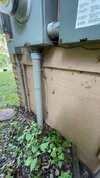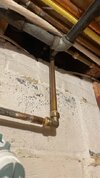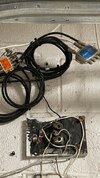It's sarcasm. The within the ( ) in captains reply is why NOT to do it that way.I cannot tell if you are being serious with your recommendations.
You are using an out of date browser. It may not display this or other websites correctly.
You should upgrade or use an alternative browser.
You should upgrade or use an alternative browser.
-
You can now help support WorldwideDX when you shop on Amazon at no additional cost to you! Simply follow this Shop on Amazon link first and a portion of any purchase is sent to WorldwideDX to help with site costs.
8ft Grounding rod: copper or galvanized
- Thread starter Radiomatrix
- Start date
Grounding is essential. It's really not an option in my opinion. But as mentioned earlier it must be done correctly. Keep all connections clean and as short as possible. All grounds MUST be at equal potential (bonded together).
I have a lifetime of experience with this stuff at work and home. Follow the NEC250, follow what the commercial cable and radio people do with tower grounding so when that electrical storm comes everything that you care about is tied to the ground system and that will keep everything at the same electrical level.
Look, with all due respect, I DO NOt come here to be entertained. Period.It's sarcasm. The within the ( ) in captains reply is why NOT to do it that way.
This is a technically leaning forum with serious answers to technical situations loaded with electrical terms and concepts that I didn’t study in college or learn OJT.
I, and am sure others less versed in the RADIO/ELECTRONICS discipline, have a hard enough time understanding and sorting through experienced based posts and technical jargon, without the cute, clever, industry inside jokes BS to drive home an idea—It only serves to further confuse the radio ignorant.
Thanks for responding.
Last edited:
Look, with all due respect, I DO NOt come here to be entertained. Period.
This is a technically leaning forum with serious answers to technical situations loaded with electrical terms and concepts that I didn’t study in college or learn OJT.
I, and am sure others less versed in the RADIO/ELECTRONICS discipline, have a hard enough time understanding and sorting through experienced based posts and technical jargon, without the cute, clever, industry inside jokes BS to drive home an idea—It only serves to further confuse the radio ignorant.
Thanks for responding.
You asked a basic, simple question. I made a basic and simple answer, cut it off. You scoffed at it and laughed. I then added sarcasm to the equation, complete with the reasons NOT to do certain things. You then said you could not tell if I was serious in my recommendations, despite the obvious sarcasm. Not sure where to go at this point. Short, blunt, to the point answer didn't work. Obvious sarcasm with reasons NOT to do it didn't work either. There were no cute, clever industry insider jokes as you call them nor was there any technical jargon other than the use of the word "inductance". Google can help with that. Your call.
move on, with thanksYou asked a basic, simple question. I made a basic and simple answer, cut it off. You scoffed at it and laughed. I then added sarcasm to the equation, complete with the reasons NOT to do certain things. You then said you could not tell if I was serious in my recommendations, despite the obvious sarcasm. Not sure where to go at this point. Short, blunt, to the point answer didn't work. Obvious sarcasm with reasons NOT to do it didn't work either. There were no cute, clever industry insider jokes as you call them nor was there any technical jargon other than the use of the word "inductance". Google can help with that. Your call.
This is a comprehensive resource for grounding, after reading it a few times, I have a better understanding of the path forward and will just go for it... I appreciate the responses from everyone for this common topic.
Can I bind the grounding rod to the nearest house fixture which is instead of plumbing, is the gas meter pipe that enters the house?
Last edited:
BJ radionut
Supporting Member and 6m addict
Well tough question really: Depending on the authority having "Jurisdiction" NEC/+ State/Local codes...Yes you can in some cases(!) However, you cannot use it as a primary system ground without certain provisions...Thus leaving that alone.Can I bind(bond) the grounding rod to the nearest house fixture, which is instead of plumbing, is the gas meter pipe that enters the house?
Logic speaking, in the event of a strike do you really want to give that lightning a path into your home via your Natural Gas Line? My thinking that after almost 40 years as a Journeyman Electrician is don't do it. Today's water supply pipes cannot be trusted to be a "primary" service grounds...to much PVC used today. I seen your pictures but that does not tell me where your shack is located vs antenna location...where and how is that feedline routing to get to the radio(s) location(s)?
All the Best
Gary/W9FNB
the antenna uses the greenhouse as a support for the bracket and the pole is anchored in a custom t-bracket i embedded in cement in a cinderblock. The house is not visible but it is to the left out of frame. The coax (feedline?) comes down, enters pvc conduit then is buried about 10” as it heads to the house where it enters the wall and into radio room ( climate controlled garage). Too much traffic between greenhouse and house and it had to be buried and out of the way. House built 66 years ago and most plumbing is copper.Well tough question really: Depending on the authority having "Jurisdiction" NEC/+ State/Local codes...Yes you can in some cases(!) However, you cannot use it as a primary system ground without certain provisions...Thus leaving that alone.
Logic speaking, in the event of a strike do you really want to give that lightning a path into your home via your Natural Gas Line? My thinking that after almost 40 years as a Journeyman Electrician is don't do it. Today's water supply pipes cannot be trusted to be a "primary" service grounds...to much PVC used today. I seen your pictures but that does not tell me where your shack is located vs antenna location...where and how is that feedline routing to get to the radio(s) location(s)?
All the Best
Gary/W9FNB
yeah, gas line a pretty darwinianly stupid thing to have considered.
All our electrical service is buried until it comes up in front of the meter way over there caddy corner to radio room. Will need to measure.
4ga stranded ground wire arrives soon.
So many variations on grounding ……. Some people just ground the base of the pole or tower, others run the grounding wire up the pole to the antenna.
That PDF link talks about solid copper gauge if run is >30ft.
That link is terrific.
the closest plumbing is 20 ft at most but inside from laundry i built this hose bib with a lot of sharkbite fittings 20 years ago. No go… The house ground is 85 feet along the hous….no go… The satellite feed uses a small gauge wire into the telco block. How lame….I guess…i dunno... no go….What i think i will do is come through the laundry wall with a 1/4 masonry bit to run some fat solid copper wire to ground the antenna to the fat water and sewer pipes in the laundry room…. I al so done with this…
Attachments
Last edited:
All of the stuff inside & outside of our home was tied to the common ground of our home yet it blew a lot of stuff up? Most all of it was nowhere near my tower & plugged into the main panel box in our home which is grounded to the main ground rod that was installed when they built our home over 22 years ago. I have seen many towers loaded with antennas struck & they were grounded very well & they were destroyed. I have even seen concrete busted from the strike where the ground wires were attached to the base of a tower.& the legs of my tower are all grounded & tied together. They are not tied to the ground rod for the house due to a very wide pour of concrete for my double wide driveway being in the way. I'm going to continue leaving mine as it was & has been for a very long time.Do what you want to but I suggest you find out a little bit more about just what causes damage. Lightning will NOT "come in on the ground lead" HOWEVER it WILL cause damage when not all grounds are tied together. This means the tower ground, station ground, and electrical entrance ground MUST all be tied together in a single common point and then that common point is used to ground your gear. If this is not done, one ground location WILL vary in electrical potential from the others and current WILL flow from one ground to the other through equipment chassis, causing the damage. Not all grounds remain at the same voltage potential during a strike but as long as they are tied together they WILL remain the same and no current can possibly flow from one ground to another.Commercial installations grounded in this manner can continue to remain on the air even when taking a direct strike.
I tested continuity from a grounded 3-prong outlet to different plumbing pipes in the laundry room and they were all bound and continuous, even the sewer dwv pipe. The outside hose bib isolated by multiple sharkbite fittings that originates from the laundry room (pic) is bound and continuous. ( who’s to say the continuity is not due to the water in the pipes?).the antenna uses the greenhouse as a support for the bracket and the pole is anchored in a custom t-bracket i embedded in cement in a cinderblock. The house is not visible but it is to the left out of frame. The coax (feedline?) comes down, enters pvc conduit then is buried about 10” as it heads to the house where it enters the wall and into radio room ( climate controlled garage). Too much traffic between greenhouse and house and it had to be buried and out of the way. House built 66 years ago and most plumbing is copper.
yeah, gas line a pretty darwinianly stupid thing to have considered.
All our electrical service is buried until it comes up in front of the meter way over there caddy corner to radio room. Will need to measure.
4ga stranded ground wire arrives soon.
So many variations on grounding ……. Some people just ground the base of the pole or tower, others run the grounding wire up the pole to the antenna.
That PDF link talks about solid copper gauge if run is >30ft.
That link is terrific.
the closest plumbing is 20 ft at most but inside from laundry i built this hose bib with a lot of sharkbite fittings 20 years ago. No go… The house ground is 85 feet along the hous….no go… The satellite feed uses a small gauge wire into the telco block. How lame….I guess…i dunno... no go….What i think i will do is come through the laundry wall with a 1/4 masonry bit to run some fat solid copper wire to ground the antenna to the fat water and sewer pipes in the laundry room…. I al so done with this…
Anyway, this brings me closer to moving on.
I am about 4 feet short of 6ga solid copper. Always something. How can i splice a few feet onto the end?
Western Union splice followed up with a propane torch and some heavy plumbers solder.I am about 4 feet short of 6ga solid copper. Always something. How can i splice a few feet onto the end?
BJ radionut
Supporting Member and 6m addict

Southwire # 6 STR - # 2 STR Split Bolt 65179140 - The Home Depot
Southwire split bolts are used in applications such as splicing, tapping, and terminating conductors in grounding applications. This bolt is constructed from a durable copper alloy. Specified for use with # 6 STR - # 2 STR Equal Run and Tap.
www.homedepot.com

iDEAL Noalox Anti-Oxidant Compound 4 oz. 30-026 - The Home Depot
Use the IDEAL NOALOX 4 oz. Anti-Oxidant Compound to improve the efficiency of aluminum conductor connections. This compound provides additional inner-strand and inner-conductor current paths. For use with pressure type wire connectors including screw-on, tap, service entrance and split-bolts.
www.homedepot.com
I had to dig around for some ideas - for you have several questions that you raised after the initial responses to the post which I just wanted to add a little more.
You mentioned painting it green.
Why?
Well, not to be too harsh, I just wanted to ask you if you've considered using what "bare metal" - being refined in purity - will cast a tone of color and hue in shade against itself as "earth" tries to apply the processes of reduction to it.
To paint something green or any paint being applied to a radiating element - you run risks of having issues with SWR on a given level of humidity (Damp wet or Dry Arid) as well as the ability to radiate and capture signal trying to cross the insulated (by what paint does as insulation or polymers added do to preserve the reduction of the paint to protect the surface it's applied on)
So - if it's not designed to radiate (like a SO-239/PL-259 connection) - sealing it provides the best protection. Meaning, painting would not affect it - it is the radiative surface is what I'm getting at.
So since you would not have any controls over the type of materials to make the paint green - why not let the process occur naturally?
The issues around copper ability to conduct in free air offer several challenges to anyone trying to "appease" the natural laws Nature applies to it's environment.
So to paint or not to paint - would be more subjective to protect that which needs to remain unmolested by time and the elements - that it answers for the point - but the free air nature - the earth-bound color it would reduce to, remains to be found by the environment you use it in.
You mentioned painting it green.
Why?
Well, not to be too harsh, I just wanted to ask you if you've considered using what "bare metal" - being refined in purity - will cast a tone of color and hue in shade against itself as "earth" tries to apply the processes of reduction to it.
To paint something green or any paint being applied to a radiating element - you run risks of having issues with SWR on a given level of humidity (Damp wet or Dry Arid) as well as the ability to radiate and capture signal trying to cross the insulated (by what paint does as insulation or polymers added do to preserve the reduction of the paint to protect the surface it's applied on)
So - if it's not designed to radiate (like a SO-239/PL-259 connection) - sealing it provides the best protection. Meaning, painting would not affect it - it is the radiative surface is what I'm getting at.
So since you would not have any controls over the type of materials to make the paint green - why not let the process occur naturally?
The issues around copper ability to conduct in free air offer several challenges to anyone trying to "appease" the natural laws Nature applies to it's environment.
So to paint or not to paint - would be more subjective to protect that which needs to remain unmolested by time and the elements - that it answers for the point - but the free air nature - the earth-bound color it would reduce to, remains to be found by the environment you use it in.




